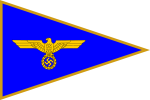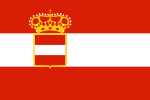
Karl Dönitz was a German admiral who briefly succeeded Adolf Hitler as head of state in May 1945, holding the position until the dissolution of the Flensburg Government following Germany's unconditional surrender to the Allies days later. As Supreme Commander of the Navy beginning in 1943, he played a major role in the naval history of World War II.

Erich Johann Albert Raeder was a German admiral who played a major role in the naval history of World War II, and was convicted of war crimes after the war. Raeder attained the highest possible naval rank, that of grand admiral, in 1939, becoming the first person to hold that rank since Henning von Holtzendorff in 1918. Raeder led the Kriegsmarine for the first half of the war; he resigned in January 1943 and was replaced by Karl Dönitz. At the Nuremberg trials he was sentenced to life imprisonment but was released early owing to failing health in 1955.
Generalfeldmarschall was a rank in the armies of several German states and the Holy Roman Empire (Reichsgeneralfeldmarschall); in the Habsburg monarchy, the Austrian Empire and Austria-Hungary, the rank Feldmarschall was used. The rank was the equivalent to Großadmiral in the Kaiserliche Marine and Kriegsmarine, a five-star rank, comparable to OF-10 in today's NATO naval forces.
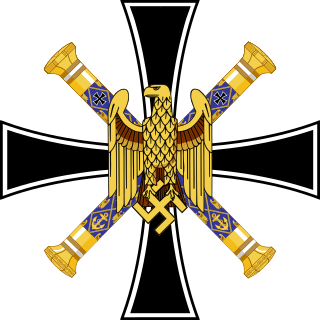
The Oberkommando der Marine was the high command and the highest administrative and command authority of the Kriegsmarine. It was officially formed from the Marineleitung of the Reichswehr on 11 January 1936. In 1937 it was combined with the newly formed Seekriegsleitung (SKL). There were two major re-organisations, in November 1939 and May 1944.

The flag of Nazi Germany, officially the flag of the German Reich, featured a red background with a black swastika on a white disc. This flag came into use initially as the banner of the Nazi Party (NSDAP) after its foundation. Following the appointment of Adolf Hitler as Chancellor in 1933, this flag was adopted as mandatory for use, while the national one was the black-white-red triband of the German Empire.

Hans-Georg von Friedeburg was a German admiral, the deputy commander of the U-boat Forces of Nazi Germany and the second-to-last Commander-in-Chief of the Kriegsmarine. He was the only representative of the armed forces to be present at the signing of the German instruments of surrender in Luneburg Heath on 4 May 1945, in Reims on 7 May and in Berlin on 8 May 1945. Von Friedeburg committed suicide shortly afterwards, upon the dissolution of the Flensburg Government.
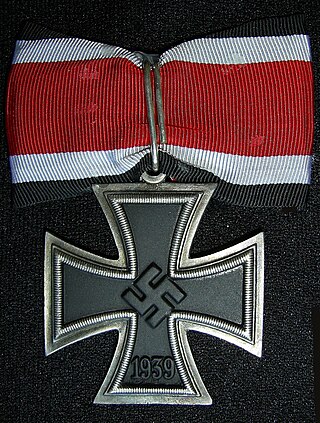
The Knight's Cross of the Iron Cross, or simply the Knight's Cross , and its variants, were the highest awards in the military and paramilitary forces of Nazi Germany during World War II.

The term Reichskriegsflagge refers to several war flags and war ensigns used by the German armed forces in history. A total of eight different designs were used in 1848–1849 and between 1867–1871 and 1945.
The Befehlshaber der Unterseeboote or BdU was the supreme commander of the German Navy's U-boat Arm (Ubootwaffe) during the First and Second World Wars. The term also referred to the Command HQ of the U-boat arm.

Rolf Hans Wilhelm Karl Carls was a high-ranking German admiral during World War II. He was a recipient of the Knight's Cross of the Iron Cross of Nazi Germany.

Kurt Fricke was an Admiral with the Kriegsmarine (navy) of Nazi Germany during World War II and a recipient of the Knight's Cross of the Iron Cross.
Hermann Rasch was a German U-boat commander of U-106 in World War II. He was a recipient of the Knight's Cross of the Iron Cross of Nazi Germany.
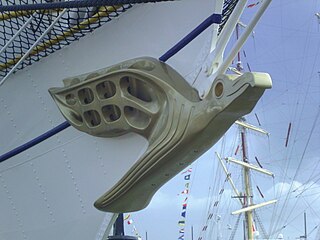
Dr. Heinrich Andreas Schroeteler was a German sculptor. During World War II, he commanded U-boat and received the Knight's Cross of the Iron Cross ; during the post-war years, he pursued a career in art history and archeology.
Generalstabsarzt and Admiralstabsarzt are in the German armed forces the rank designations of the second highest grade of the generals rank group.
Erich Johann Albert Raeder was a naval leader in Germany before and during World War II. This article covers Raeder's life as the Großadmiral up to the start of World War II. Raeder attained this naval rank, the highest possible, in 1939, becoming the first person to hold that rank since Alfred von Tirpitz. Raeder led the Kriegsmarine for the first half of the war; he resigned in 1943 and was replaced by Karl Dönitz. He was sentenced to life in prison at the Nuremberg Trials, but was released early due to failing health. Raeder is also well known for dismissing Reinhard Heydrich from the Reichsmarine in April 1931 for "conduct unbecoming to an officer and a gentleman".
Erich Johann Albert Raeder was a naval leader in Germany before and during World War II. Raeder attained the highest possible naval rank – that of Großadmiral – in 1939, becoming the first person to hold that rank since Henning von Holtzendorff. Raeder led the Kriegsmarine for the first half of the war; he resigned in 1943 and was replaced by Karl Dönitz. He was sentenced to life in prison at the Nuremberg Trials, but was released early due to failing health.
Generaloberstabsarzt and Admiraloberstabsarzt are the top Joint Medical Service OF8-ranks of the German Bundeswehr. The equivalent to this ranks in the Heer is Generalleutnant and in the German Navy the Vizeadmiral.
Generalarzt is the designation of a military rank as well as the official title in German speaking armed forces. It is equivalent to the Admiralarzt / Generalapotheker and Brigadegeneral / Flottillenadmiral.























